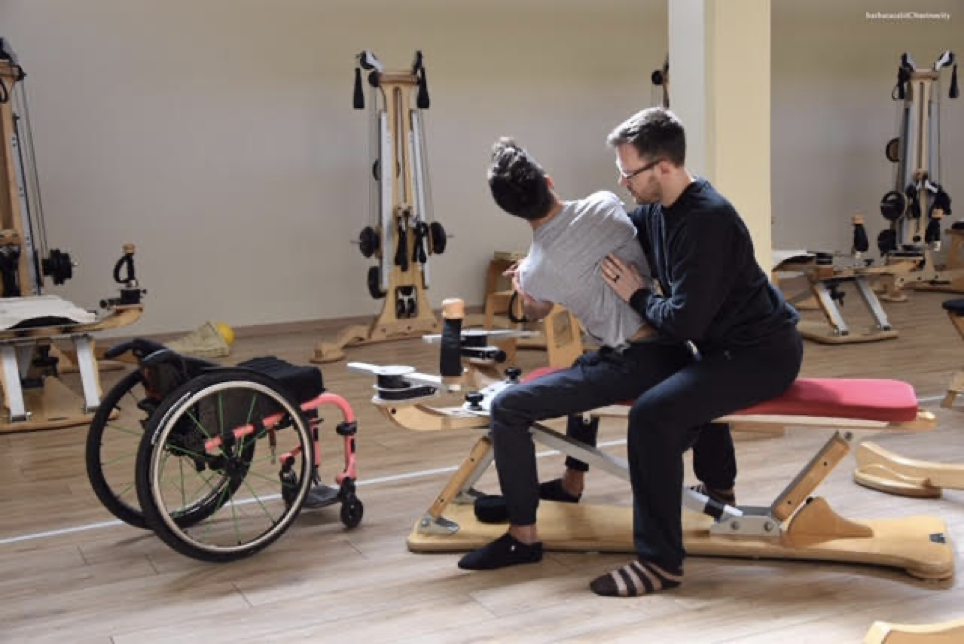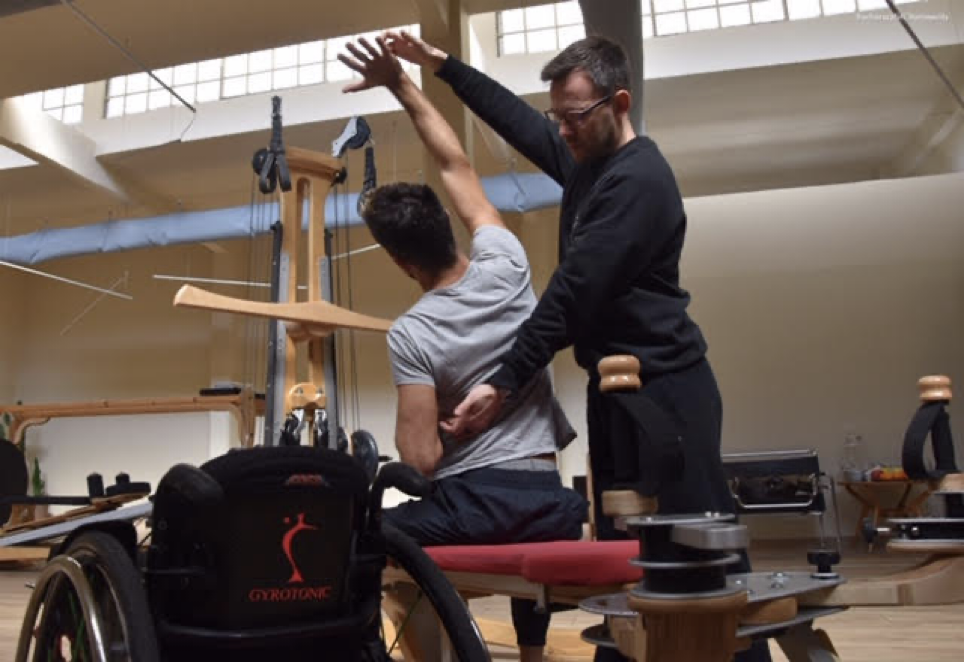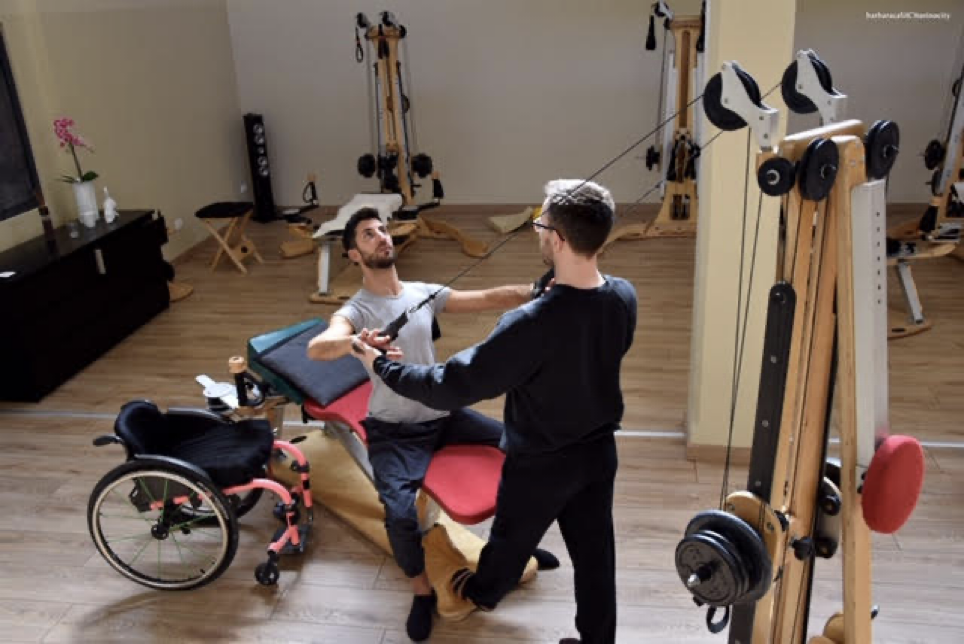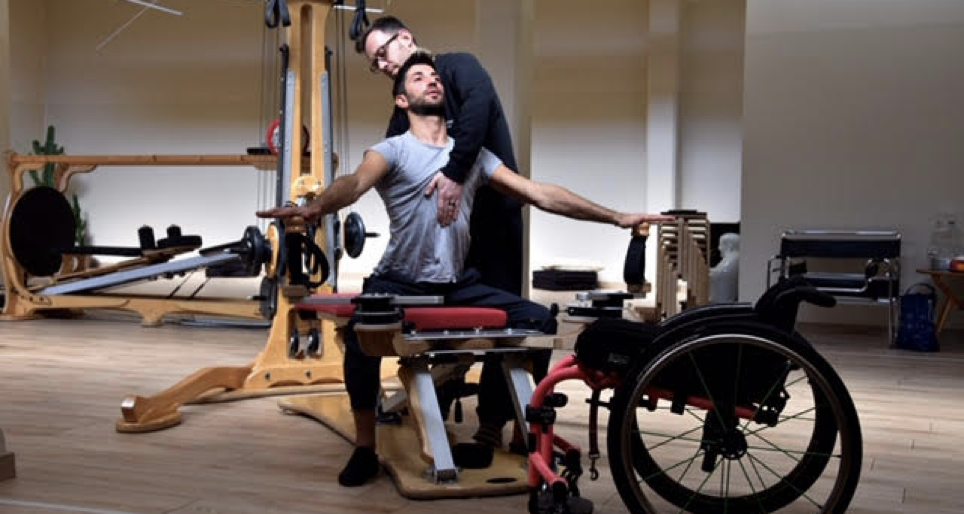Paraplegic Spinal Cord Injuries and the GYROTONIC® Method
Blog Content Interviews // April 05, 2023
Igor Abbà, a GYROTONIC® Master Trainer, recently spoke with Cina Canada, Media Coordinator for GYROTONIC® International Headquarters, to discuss his work with paraplegic clients and how he uses the Gyrotonic and Gyrokinesis Methods to help them find peace with their spine.
CINA: Tell me where you’re based, the name of your studio, the website address, and any kind of contact information I might need.
IGOR: I’m from Torino, Italy. The studio’s name is GYROTONIC® Torino, and the web page is gyrotonic-torino.com.
CINA: How long have you been at your studio?
IGOR: It’s been 22 years. Wow! I started so long ago, with one Pulley Tower in my house. At that time, I was half teaching and half dancing. I stopped dancing because of my hip. That’s why I started the Gyrotonic Method – for my hip. When I stopped with dance, and I started to build up a Gyrotonic Movement studio in Torino with Gloria Cesana. Now we have six Pulley Towers and all the specialized equipment. It’s getting bigger and bigger.
Speaking of teacher training courses, the most interesting thing for me in my work of the past six years is finding a good way to help the students learn the material without pushing the material onto them. They already know a good part of the program. They have experimented with it on themselves, and they know their strengths and their doubts.
The Foundation Course adds a well-defined, hands-on structure with a coherent progression to build on everything that is possible from the Level 1 program.
If we zoom out and look at everything from a little further away, we realize that it is like being in front of a well-defined grid, which we define precisely as the “system”. The clearer the grid, the freer we are to move within it, and this is where things get interesting for me.
Obviously, we are talking about a personal point of view. For me, being a trainer is a “service action”. That means tuning-in with who we are facing, in the context that we are improving the person’s quality of life for an hour or a week, depending on what the moment requires, all without trying to sell personal wonders, such as what made us excited during our Gyrotonic Method lessons, because they are not superimposable to the person with whom we are facing.
The Foundation Course and the Apprenticeship Review Course are great places to experience these moments: we are beings within a space, we all carry with us our body (more or less healthy), our emotions (which also include insecurities or false certainties), and our brains (understood as our way of seeing or imagining things and our ability to be creative).
The degree of confidence during the courses is such that, without realizing it, we can easily let our “less noble” attitudes emerge. It’s like an amplification of what can happen with clients.
Therefore, my proposal to the students is to try to manage this aspect of the session as well.
How can we do it? I’ve developed a few tricks over time. Let’s say the goal is to expand observational skills. Observe the context in its entirety, include us in it, and then learn to observe ourselves from the outside. It seems simple, but in reality, it requires perseverance and a lot of concentration, which, as we know, is not inexhaustible during the day.
These aspects become even more important when working with people with disabilities.
CINA: Let’s get into that. What started you on the journey of working with mobility-limited clients?
IGOR: This happened because someone with a spinal lesion, Lorenzo Spadafora, called me to take the GYROTONIC® Foundation Course. He was in a wheelchair and wasn’t able to do the usual hands-on that we learn in teacher training. I had to find different ways to help him understand what’s happening in the body of the client, and how he can help the client in different ways. This was amazing and very inspiring for me.
CINA: So, he is in a wheelchair, and he’s not coming to you for sessions; he’s coming to you to learn how to be a trainer. How did that go with his Foundation Course?
IGOR: I had never worked with anyone in this kind of situation. I thought, “Wow, let’s see what’ll happen.” He’s amazing because he is a young man, so he can do everything; skiing, skydiving, and he’s got a license for driving boats. He really can do everything. He’s full of energy. When I realized the possibilities, I told myself, “Ok, we can go deeper into the material, starting from the very basic principles like the yawning sensation in the spine, the innermost point of the spine where you can feel the yawn, and then go from there.” You have to reach the balance through an inner contrast, so I started working with this, and it was amazing. It also helped me to see what was the best way without forcing.

Igor Abbà
CINA: So, he completed his Foundation Course, and now he’s a Gyrotonic Trainer.
IGOR: Yes, now he’s teaching, and I’m still working with a Paralympic athlete.
CINA: Ah, so you were inspired and continued on.
IGOR: Yeah. Patrizia Saccà was a bronze medalist at the Barcelona Paralympics and gold medalist at the 2013 World Master Games in table tennis. She also has very bad scoliosis.
I met Patrizia in a yoga course. She’s a yoga trainer. We started to talk a little, and she’s had pain in her spine for a long time. We tried to fix the material so that it could be good for any kind of situation, not only for a spine that’s so difficult to manage. She talked to me about many aspects to consider when you work with paraplegics. Then she got on the bench and started doing some exercises. We started with elongation of the spine without the handle. In a very short time, she totally changed her perception of the spine. She told me, “Thanks to the Gyrotonic Method, I’m now at peace with my spine.” When you have an accident like this, you cut your perception of this part. You feel uncomfortable with your spine because the spine is your problem.
CINA: Great, I’ll come back to Patrizia. Jumping back to Lorenzo, how did you start when he first came in?
IGOR: I said, “Ok, you are here for a Foundation Course, so you have already done a Pre-training Course. Let me see what we can do.” He jumped on the bench, and he was ready.
CINA: He can’t push into the floor, so you just start with the Arch and Curl?
IGOR: He used the force of the shoulder and spine more. Every situation is different, depending on where the lesion is. For example, Patricia has abdominals. With Lorenzo, I started to work on the balance. We started to work with some elongation in the upright position, just breathing and elongating the spine with the breath while using the back support for help.
CINA: Because he can push into his back. Ok, interesting.
IGOR: He can push on it with the hands to start to elevate the spine, so we start with spine plus arm, then we do spine lift plus spiral, then spine lift and spiral plus arm, then we add the sideways arch… and so on.
Then we get into the upper-body series. It was hard for Lorenzo because he has to find the relationship between the cable and the spine for the balance. So we can say it’s a study of balance within elongation — a work on limits, including mine.

Igor Abbà
CINA: Right, of course. So, if we were on there, we would reach through the fifth line, but with Lorenzo, you would have him push…
IGOR: The seed center down and the spine up.
CINA: Which makes sense because he doesn’t have abdominals, but he can keep the intention of his spine.
IGOR: Yes, he can have the intention of his spine. His lesion is not complete, so he can move a toe, for example, and he’s got perception in the leg. So it’s different than people who don’t have the tactile sensation or perception of part of the body. Patricia doesn’t have tactile sensation, for example, but she can use the gluteus. It’s completely different if you start to lift your spine from the gluteus than if you start to lift the spine from the spine.
CINA: Ok, so how does that compare? Tell me about the first time Patrizia came in. How did you start working with her?
IGOR: She’s got the abdominals, so we started out with the back support again. You have to breathe with your spine, and you have to yawn with your spine. Then we start with the Arch and Curl, just moving forward and back in that arch position. They need to extend the spine because they are sitting all the time with their backs hunched over.
CINA: From the bench or from the wheelchair?
IGOR: From the bench. The wheelchair is not always stable enough. They can fall down. It’s not always a good idea. So, from the bench, with arch and arch, expand forward and try to suspend and lift the spine from the back and suspend again. With this kind of feeling, like a little boat floating. From this, it’s very easy to go into a full arch movement and then into the Arch and Curl, or diving, for example. From this point on, you can try to do everything, depending, of course, on the student. Some exercises are easier, and some exercises are more difficult because of the balance or the shoulder pain.

Igor Abbà
CINA: What exercises have you found with Patrizia, for example, to be the most useful? Where have you seen the most success?
IGOR: Well, the diving in every situation.
CINA: On the handle units?
IGOR: Yes, on the handle units, but even with the cable, as in the Upper Body Series.
CINA: Sitting on the end of the bench?
IGOR: Yes, for example, the swimming. Not the regular one, but starting from the chest open in arch, then letting the body fall back, then coming back to the front in curl. Opening the chest again, they dive into the balance point. Each time that they exercise, they have to be able to find the balance point.
Let’s go back to the discussion regarding teacher training. As each situation can be completely different, you can’t copy and paste. As trainers, we need to be concentrated and find that neutral area that allows us to expand our gaze. The surrounding space is even more important because it can turn into an obstacle. Have a clear intention of what you want to achieve with an exercise. Let creativity emerge from the fundamental principles of the Method (like the grid mentioned earlier). Keep an open heart because some exercises can have an emotional impact. It is most important to realize this, in a nutshell, that we need to be apprentices again and again.
CINA: That seems very important, especially if you’re talking to people who have lost many sensations and you’re trying to tap into whatever sensations they do have. How can we nurture those sensations and maybe get more sensations?
IGOR: I think the best way is to be attentive to the context, clarify the goals and keep all channels open, visual, creative, and emotional. Don’t discard solutions in advance.
I think it’s useful to pass on this information during the training courses, when possible. It makes everything more dynamic, and above all, each course is different because the students are different. The difficulties and solutions come from the working group and are not simply labeled by me as right or wrong. I love working with collective intelligence, it enriches me and the group, and sometimes unexpected solutions arise.
For example, I ask trainers to be very precise on the space where they are and where they move. The changing space between you and the client can lead to a change in that person’s body perception — an emotional change in the person or the touch of the hands. There are people that if you are too nice to them, they feel uncomfortable.
CINA: Exactly, and you have to feel that.
IGOR: Yes, I ask trainers to be very, very sensitive about their “antennas”.

Igor Abbà
CINA: It’s really your intuition as well.
IGOR: Yes, it is. It’s like being three-dimensional, not only in movement but also in teaching. Gyrotonic movements are three-dimensional, but next to the equipment, there is me, the client, and the quality of the relationship between the two, and I love this 3-D relationship.
CINA: We function on an emotional level, just as much as a physical level, in those dimensions.
IGOR: The physical part is only where you put your feet and what you touch with your body. It can change or have different nuances if placed in a larger context.
CINA: Right. When you’re with a client, you’re feeling from that intuitive place because you’re empathizing with what they’re feeling. When you’re with somebody who has a spinal cord injury, and they have little to no feeling, do you ever have a hard time imagining their sensations and what they’re feeling and imagining because they experience so differently?
IGOR: You have to try to feel it in some different way. There are some little tricks we can use, it’s a work in process, and it is a part of the course that we offer together with Lorenzo.
CINA: Do you now specialize in working with people with spinal injuries?
IGOR: We now have a specialized program called GYROTONIC® Applications for Paraplegic Spinal Cord Injuries. I say “we” because I’m developing this course with Patrizia and Lorenzo. There are a lot of paraplegic people in Italy who are now interested in using the Gyrotonic Method.
CINA: What would you say to somebody who’s in a wheelchair and they’re thinking, “I can’t do something like that?” What would your message be?
IGOR: In very few classes, you can have a different quality of life. You can start to feel and manage the spine and the body in a better way. The Gyrotonic Method is not only about movement; you can really have peace with your spine. I think those are the best words that I received from Patrizia, Lorenzo, and other people with disabilities, so that’s the best I can share.
To learn more about Igor and his teaching schedule, please visit gyrotonic-torino.com.
If you are a Gyrotonic Trainer interested in learning more about working with spinal cord injuries, check out the Specialized Course GYROTONIC® Applications for Paraplegic Spinal Cord Injuries
We also did an interview with one of Igor’s past students, Lorenzo Spadafora, a Gyrotonic trainer who shared his journey and experiences in the post Teaching the GYROTONIC® Method From a Wheelchair
If you enjoyed this interview, be sure to read these other inspiring interviews with licensed trainers:
Healing From Trauma With Movement – A Personal Experience
From Feeding Tube, Wheelchair, and Pain Medication, To Freedom!
How the GYROTONIC® Method Can Improve Training For High Level Athletes
Use our Studio Finder tool to find a GYROTONIC® or GYROKINESIS® class near you!
To learn more about how to become a Gyrotonic or Gyrokinesis Trainer, visit our Teacher Training page.
